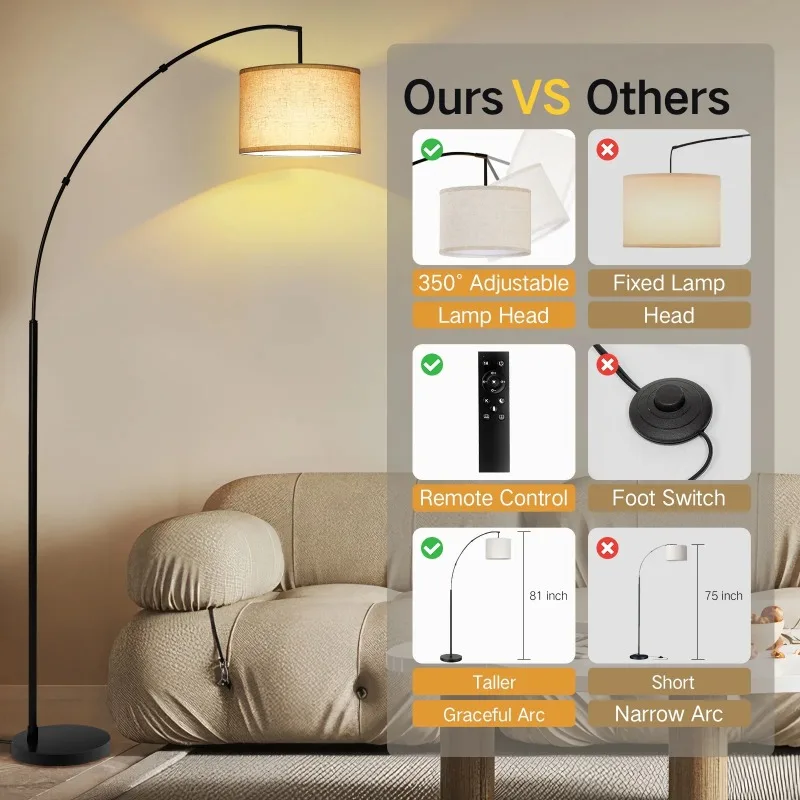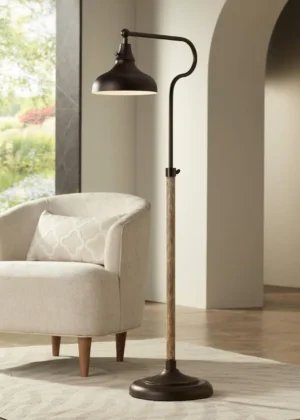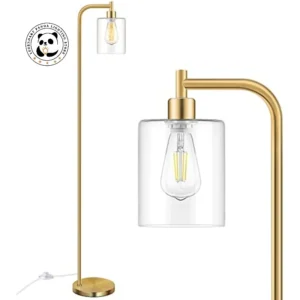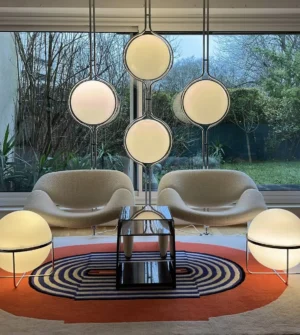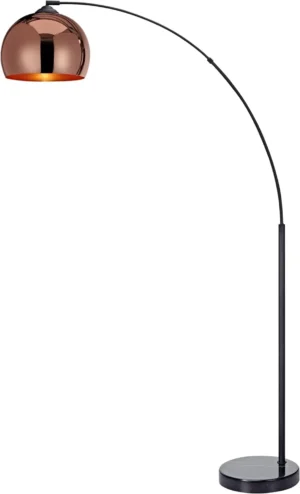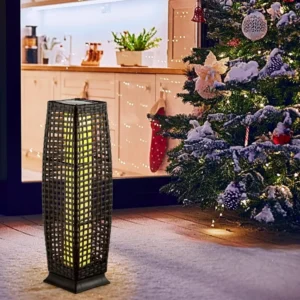Introduction: Why Dimmable Arc Lamps Transform Living Spaces
Arc lamps have evolved dramatically from traditional floor lighting to become stunning statement pieces in modern homes. These distinctive fixtures combine an elegant curved arm that extends gracefully from a weighted base, suspending a light source over your seating area or table without requiring ceiling installation.
What makes dimmable arc lamps particularly special is their versatility. Unlike standard lighting that offers only “on” or “off” options, these sophisticated fixtures provide complete control over brightness levels. This adjustability transforms a single lamp into multiple lighting solutions – from bright illumination for reading to soft ambient lighting for entertaining or relaxation.
The rising popularity of dimmable arc lamps stems from their perfect balance of form and function. They serve as architectural statements and conversation starters while delivering practical, customizable lighting. Their sweeping silhouettes add drama and visual interest to spaces that might otherwise lack distinctive design elements.
In this comprehensive guide, we’ll explore everything you need to know about selecting the ideal dimmable arc lamp for your living space. We’ll cover various styles, essential features, dimming technologies, and practical considerations to help you find a lamp that enhances both your décor and daily life. Understanding the fundamentals of dimmable arc lighting transforming space will help you make an informed decision that combines beauty with functionality.
The Transformative Impact of Dimmable Arc Lamps on Living Spaces
The primary advantage of dimmable arc lamps lies in their lighting versatility. With precise brightness control, a single fixture can transition seamlessly from bright task lighting for reading or crafting to subdued ambient lighting for movie nights or intimate conversations. This adaptability eliminates the need for multiple light fixtures serving different purposes, simplifying your lighting scheme while enhancing functionality.
Arc lamps solve a common design challenge by providing overhead illumination without requiring electrical work or ceiling fixtures. Their arching design delivers light precisely where needed – over a reading chair, dining table, or sofa – without consuming valuable table space or requiring professional installation. This makes them perfect for renters or anyone seeking to avoid structural modifications to their home.
Beyond practical benefits, these lamps create dramatic visual impact. Their sculptural silhouettes introduce an architectural element that draws the eye upward, creating a sense of height and movement within the space. The graceful curve of an arc lamp adds a dynamic quality that static lighting simply cannot match, functioning essentially as functional art within your interior landscape.
The combination of adjustable positioning and dimmable lighting allows these fixtures to adapt to multiple scenarios throughout the day. Many arc floor lamps for mood lighting feature adjustable heads or arms that can be redirected as needed, providing focused light for specific activities or broader illumination for general use. This flexibility makes them particularly valuable in multipurpose spaces where lighting needs frequently change.
Essential Components and Mechanics of Dimmable Arc Lamps
The distinctive arc structure forms the lamp’s visual signature and determines its functional reach. Arc designs range from gentle curves to dramatic sweeps, with heights typically ranging from 60-80 inches (150-200 cm) and horizontal reaches extending 30-50 inches (75-125 cm). Some premium models feature adjustable arcs that can be raised, lowered, or extended to customize the light position for different seating arrangements or room configurations.
Base design critically affects both stability and aesthetics. Given the extended reach, bases must provide sufficient counterbalance to prevent tipping. Common base materials include heavy marble (weighing 15-25 pounds/7-11 kg), weighted metal discs, or broad flat designs that distribute weight effectively. The base footprint typically ranges from 10-16 inches (25-40 cm) in diameter, requiring consideration when planning room layout.
Shade design significantly impacts both light direction and overall appearance. Downward-facing shades provide focused task lighting ideal for reading areas, while open-bottom designs create broader light dispersion. Materials range from metal domes that direct light precisely to fabric drums that diffuse illumination more gently. Some contemporary designs feature adjustable shades that can be angled or rotated to direct light where needed.
The internal wiring and adjustable arc lamp functionality constitute the technical heart of these fixtures. Quality models feature well-secured internal wiring running through the curved arm, with reinforced connections at bending points to prevent wear. Dimming circuits must be compatible with the specified bulb types, with some advanced models incorporating dimming modules that maintain consistent performance throughout the brightness range without flickering or buzzing.
Key Features to Consider: Dimming Technologies and Mechanisms
Foot Dimmer Switches
Foot-operated dimmers offer convenient hands-free operation, typically positioned along the power cord within easy reach of your foot. This mechanism allows brightness adjustment without interrupting your activities – particularly useful when you’re holding a book or engaged in conversation. Quality foot dimmers provide smooth, continuous dimming rather than preset levels, though they may have limited durability compared to other mechanisms.
Rotary Dimmer Controls
Rotary knobs provide precise brightness control through a simple turning motion. These dimmers may be positioned on the lamp pole, shade housing, or inline on the cord. Their advantage lies in fine adjustment capability and intuitive operation. Higher-end models feature smooth, continuous dimming with tactile feedback, while budget options might offer stepped brightness levels that jump noticeably between settings.
Remote Control Systems
Remote-operated dimming brings convenience for lamps positioned in hard-to-reach locations or when controlling multiple lighting sources simultaneously. Standard remotes operate via infrared (requiring line-of-sight to the receiver) with a range of approximately 15-20 feet (4.5-6 meters), while more advanced radio frequency remotes work through obstacles with extended range. Some systems offer programmable settings to save favorite brightness levels for different activities.
Smart Home Integration
The latest dimmable features in modern arc lamps include compatibility with smart home ecosystems like Alexa, Google Home, and HomeKit. These systems enable voice-activated brightness control, scheduled lighting changes, and integration with other smart home routines. Some smart-enabled lamps feature additional capabilities like color temperature adjustment, scene programming, or energy usage tracking, though these advanced features typically command premium prices.
Selecting the Right Bulbs for Your Dimmable Arc Lamp
LED bulbs represent the optimal choice for modern dimmable arc lamps, offering approximately 80% greater energy efficiency than traditional incandescent options. With lifespans exceeding 25,000 hours (compared to just 1,000-2,000 hours for incandescents), quality LEDs provide years of service before replacement. When selecting LEDs for dimming applications, look specifically for “dimmable” designation on packaging, as standard LEDs may flicker, buzz, or fail to dim smoothly.
Understanding brightness measurement helps ensure appropriate illumination. While traditional bulbs were classified by wattage (power consumption), modern lighting uses lumens (light output). For living spaces, 800-1,100 lumens typically provides comfortable ambient lighting, with higher ranges suitable for task-oriented areas. Many quality arc lamps support bulbs delivering 1,200+ lumens at maximum brightness, dimmable to under 100 lumens for subtle mood lighting.
Color temperature significantly impacts the mood and functionality of your lighting. Measured in Kelvins (K), lower temperatures (2700-3000K) produce warm, yellowish light resembling traditional incandescent bulbs – ideal for creating cozy, inviting atmospheres in living spaces. Higher temperatures (3500-4000K) generate cooler, bluer light better suited for task-focused areas. Some premium LED arc floor lamp models offer adjustable color temperature, allowing transition between warm and cool lighting to match different activities.
Color Rendering Index (CRI) measures how accurately a light source reveals colors compared to natural daylight. Higher CRI values (90+) produce more faithful color reproduction – particularly important when the lamp illuminates artwork, furnishings with subtle color variations, or spaces where color accuracy matters. Budget bulbs often have CRI ratings of 80 or below, which may make colors appear slightly flat or distorted compared to higher-quality options.
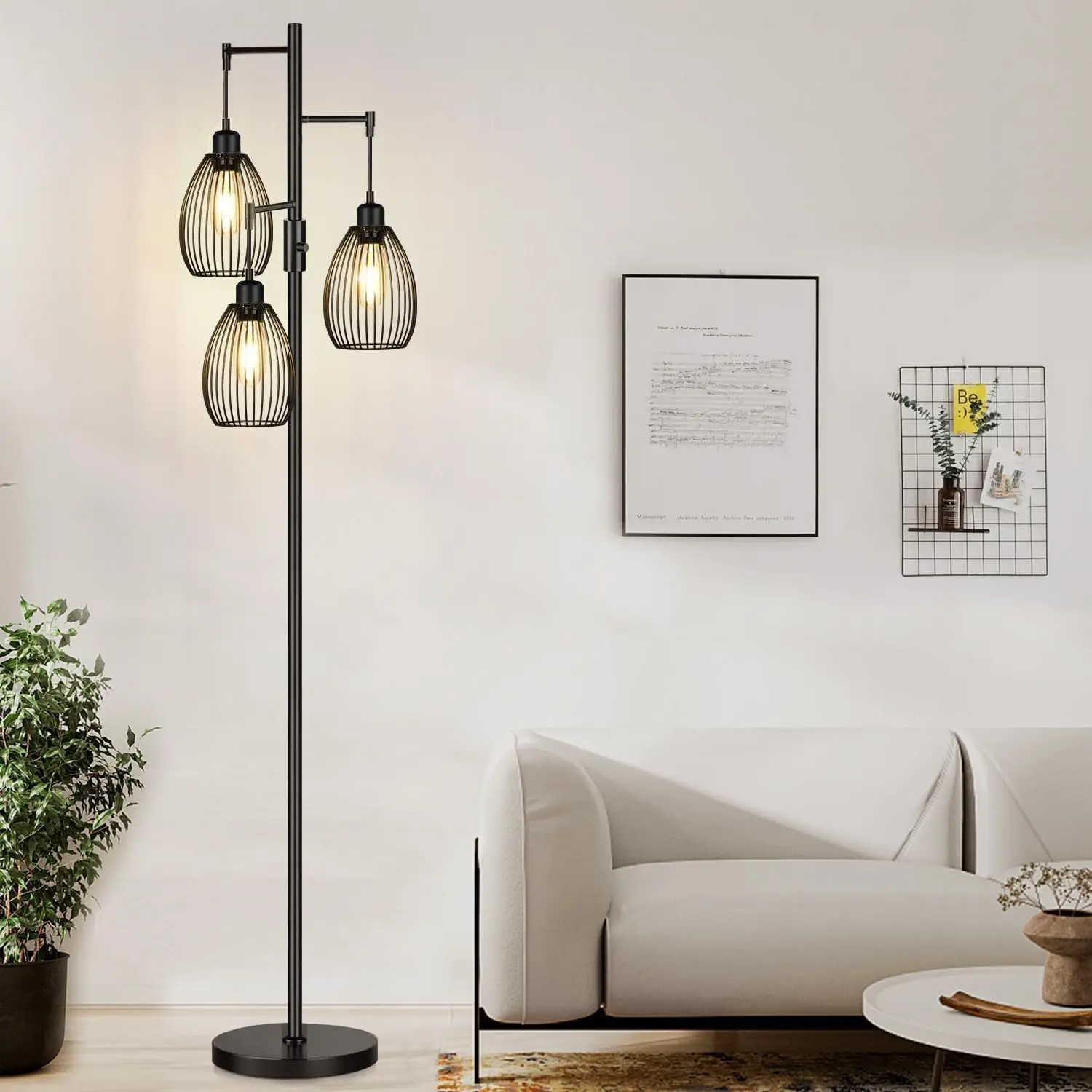
Material Quality and Aesthetic Considerations
Metal finishes significantly influence both the lamp’s visual impact and its compatibility with existing décor. Brushed nickel and chrome create contemporary, cool-toned statements that complement modern interiors, while brass brings warmth that pairs beautifully with mid-century or traditional designs. Matte black offers versatile sophistication that works across various styles, creating dramatic silhouettes without overwhelming other design elements. Consider how metal finishes interact with existing hardware in your space for visual cohesion.
Natural materials add warmth and organic texture to what might otherwise be a purely industrial form. Marble bases, typically weighing between 15-25 pounds (7-11 kg), provide both stability and luxury appeal with unique veining patterns that make each lamp subtly unique. Wooden elements – whether in bases, accent details, or entire arcs – introduce natural warmth and can soften the lamp’s technological presence. These materials generally command higher prices but offer distinctive character that mass-produced options cannot match.
Shade materials profoundly affect light quality and distribution. Fabric shades diffuse light gently, creating soft, ambient illumination ideal for living areas seeking warm glow rather than task lighting. Metal shades direct light more precisely downward, making them suitable for reading or focused activities. Glass and acrylic options offer transparency that minimizes visual weight while potentially creating interesting light patterns. The dimmable arc floor lamp shade material should align with both functional needs and aesthetic preferences.
Construction quality reveals itself in details like seamless joints, smooth finish transitions, and weighted stability. Look for reinforced connections where the arc meets the base, as this junction bears significant stress. Quality wiring should be well-protected yet invisible, with dimmer mechanisms operating smoothly without clicking or sudden brightness jumps. Shade attachments should allow adjustment without wobbling or slipping, and all components should feel substantial rather than flimsy when touched or adjusted.
Finding Your Perfect Size: Dimensions and Placement Guidelines
Height proportions must balance with your ceiling height and surrounding furnishings. A helpful formula for determining appropriate lamp height: subtract 24-30 inches (60-75 cm) from your ceiling height to find the ideal maximum height. This ensures adequate clearance while maintaining visual proportion. In spaces with standard 8-foot (2.4-meter) ceilings, arc lamps between 5.5-6.5 feet (1.7-2 meters) tall provide ideal scale without crowding the vertical space.
Arc length and reach should correspond directly to your furniture arrangement. For optimal positioning above seating, the arc should extend approximately 20-35 inches (50-90 cm) from the base, allowing the lamp to stand slightly behind or beside furniture while suspending light exactly where needed. Measure the distance from your intended base position to the center of the seating area to determine appropriate reach requirements.
Base footprint requires careful planning in your layout. Most substantial arc lamps require bases 12-16 inches (30-40 cm) in diameter to ensure stability. Allow adequate clearance around the base for foot traffic and cleaning access. Position bases where they won’t create tripping hazards or obstruct pathways – typically alongside furniture rather than in open floor areas. Many of the best arc lamps for living rooms feature thoughtfully designed bases that balance size with stability.
Ideal placement typically positions the light source 12-16 inches (30-40 cm) above head height when seated, or approximately 60-65 inches (150-165 cm) from the floor. This elevation prevents glare while providing effective illumination for reading or conversation. For dining applications, position the light center approximately 30-36 inches (75-90 cm) above the table surface to illuminate the area without obstructing sightlines across the table.
Design Styles: Finding the Perfect Aesthetic Match
Modern and contemporary styles emphasize clean lines and minimalist sensibilities. These arc lamps typically feature slender metal arcs with minimal embellishment, often in chrome, brushed steel, or matte black finishes. Shade designs tend toward simple geometric forms – perfect cylinders, spheres, or cones – that complement architectural spaces. The overall effect prioritizes function and form equally, with careful attention to proportion and balance rather than decorative details. These designs work particularly well in spaces with open floor plans, neutral color palettes, and current furniture styles.
Mid-century modern options draw inspiration from the 1950s and 1960s design movements, characterized by organic curves combined with geometric simplicity. These lamps often feature warm metal tones like brass or copper with tapered legs or distinctive shade shapes. Many incorporate wood elements or accent details that reference the era’s appreciation for natural materials alongside industrial innovation. The iconic Arco lamp (designed in 1962) influences many contemporary interpretations with its distinctive marble base and dome-shaped shade.
Industrial designs celebrate mechanical aesthetics and workshop-inspired elements. These lamps often feature exposed hardware, visible joints, and materials like blackened steel, aged brass, or raw metals. Adjustability mechanisms may be highlighted rather than concealed, with tension springs, counterweights, or articulating joints becoming part of the visual appeal. Shades typically feature metal construction with factory-inspired shapes or cage designs that reveal the bulb within. These styles complement brick walls, concrete elements, and other raw architectural features.
Minimalist approaches reduce the arc lamp to its essential elements, removing anything unnecessary to create understated elegance. These designs often feature incredibly slim profiles, hidden connection points, and perfectly balanced proportions. Color palettes typically remain neutral – blacks, whites, and metallics – allowing the sculptural form to speak for itself. Rattan arc floor lamp options bring organic texture to minimalist designs, creating interesting visual contrast through natural materials rather than complex design elements.
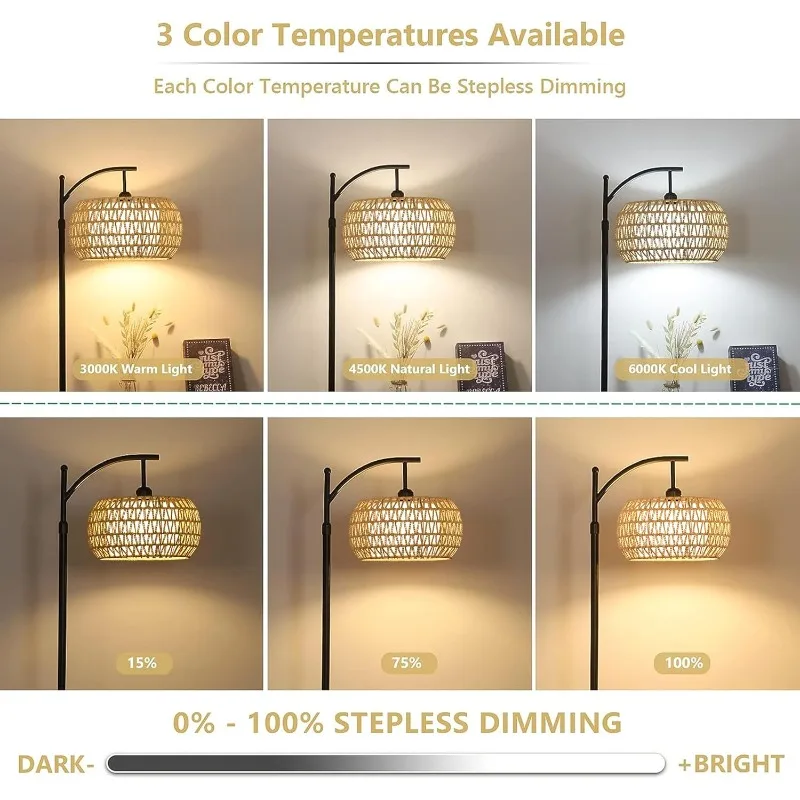
Integrating Dimmable Arc Lamps into Your Existing Interior Design
When complementing existing decor, consider both harmony and contrast strategies. For harmony, match metal finishes with existing hardware in the space (drawer pulls, curtain rods, or other lighting fixtures) to create visual consistency. Alternatively, use strategic contrast – such as introducing a brass arc lamp into a predominantly silver-toned space – to create a deliberate accent piece. The lamp’s scale should balance with your largest furniture pieces; too small and it loses impact, too large and it overwhelms the space.
Arc lamps naturally create focal points through their dramatic silhouettes. Position your lamp where its curve can be fully appreciated, typically with some visual space around it rather than crowded among furniture. The lamp’s arc can direct attention to important design elements – framing a piece of art, highlighting an architectural feature, or defining a conversation area. In open-concept spaces, use the lamp to visually separate functional zones without erecting physical barriers.
Effective lighting design relies on layering different light sources at various heights. Creating ambiance with dimmable arc lamps works best when complemented by other lighting types – perhaps recessed ceiling lights for general illumination, table lamps for mid-level light, and perhaps accent lighting for specific features. The arc lamp typically serves as both mid-level and overhead lighting, with its dimmable feature allowing it to transition between these roles as needed throughout the day.
Room size significantly affects appropriate lamp scale. For spaces under 200 square feet (19 square meters), consider arc lamps with moderate reach (around 30 inches/75 cm) and simplified bases to avoid overwhelming the room. Larger spaces can accommodate more substantial designs with extended reaches (40+ inches/100+ cm) and dramatic proportions. The lamp should feel proportionate to the room – typically occupying no more than one-eighth of the total floor space through its visual footprint.
Top Dimmable Arc Lamp Categories: A Curated Selection
Budget-friendly options (under $300) typically feature simplified designs with focused attention on essential functions. These lamps often use lightweight materials like hollow steel tubing for the arc and composite bases with metal overlays rather than solid marble. While they may lack premium features like remote dimming or smart connectivity, quality options in this category still offer smooth dimming functionality, stable bases, and attractive finishes. Look for models that prioritize electrical component quality over decorative elements for long-term satisfaction.
Mid-range selections ($300-600) represent the sweet spot for many buyers, balancing quality construction with thoughtful design details. These lamps typically feature more substantial materials – thicker gauge metals, partial marble components, or quality wood elements – with greater attention to finishing details. Dimming mechanisms tend to be more refined, with smoother transitions and better compatibility across bulb types. Many feature adjustability options like height variation or shade positioning that budget models lack.
Premium design choices ($600+) elevate the arc lamp from functional fixture to design statement. These lamps often feature materials like solid marble bases, premium metal finishes with hand-applied patinas, or architect-designed proportions. Advanced features might include integrated LED arrays with color temperature adjustment, custom-designed dimming systems, or articulation points that allow the lamp to adapt to various positions. Construction quality should be impeccable, with perfect weighting, invisible wiring, and flawless finish quality.
Adjustable arc floor lamp models offer versatility through multiple positioning options. These designs feature mechanisms like adjustable height stems, swiveling shade housings, or articulating arms that can be reconfigured to serve different purposes. Some incorporate counterbalance systems that allow easy positioning without tools or complicated adjustments. This adaptability makes them particularly valuable in multifunctional spaces where lighting needs regularly change.
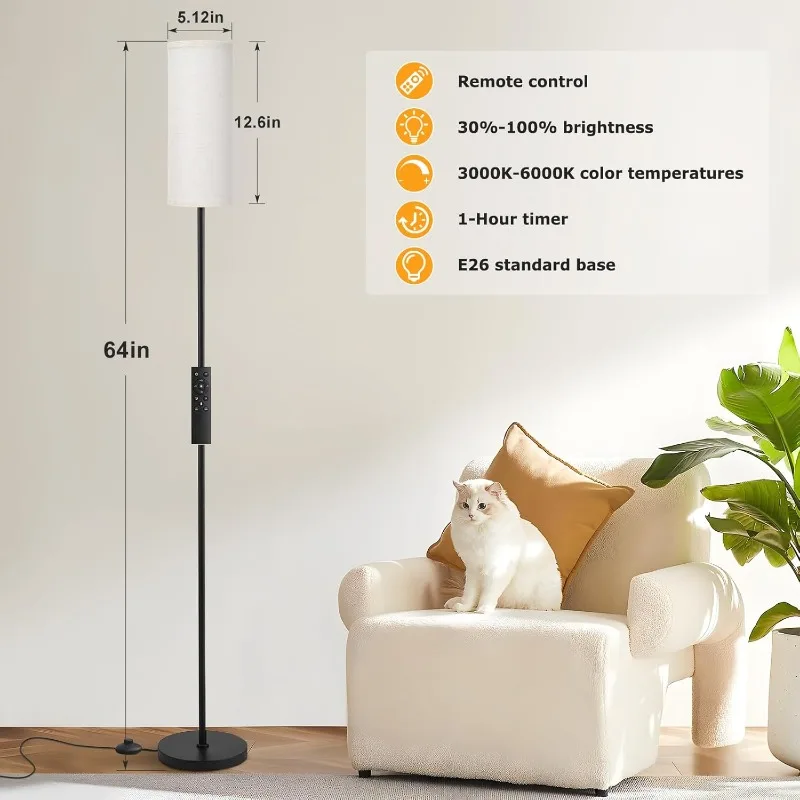
Adjustable Arc Floor Lamp, Bronze Arc Floor Lamp
Price range: $440.95 through $558.52 Select options This product has multiple variants. The options may be chosen on the product pageBrass Arc Floor Lamp, Contemporary Arc Floor Lamp, LED Arc Floor Lamp
Price range: $490.72 through $522.04 Select options This product has multiple variants. The options may be chosen on the product pageChrome Arc Floor Lamp, LED Arc Floor Lamp
Price range: $304.95 through $1,210.40 Select options This product has multiple variants. The options may be chosen on the product pageContemporary Arc Floor Lamp, Large Arc Floor Lamp, Marble Base Arc Floor Lamp
$224.94 Select options This product has multiple variants. The options may be chosen on the product pageLED Arc Floor Lamp, Rattan Arc Floor Lamp
$313.58 Select options This product has multiple variants. The options may be chosen on the product page- $1,003.85 Select options This product has multiple variants. The options may be chosen on the product page
Installation, Setup and Care: Maximizing Your Lamp’s Potential
Assembly of arc lamps typically involves connecting the base, vertical support, and curved arm sections. Begin by identifying all components and hardware before assembly. Place the base on a flat surface, then attach the vertical support securely using provided hardware – this connection should be particularly tight as it bears significant weight. The arc section typically attaches last, often with threaded connections or bolts. Once assembled, perform a stability test by gently pushing the lamp at various points to ensure it doesn’t wobble or tip easily.
Positioning your lamp correctly maximizes both visual impact and lighting effectiveness. For reading areas, position the shade so light falls over the shoulder of the seated person, typically 16-20 inches (40-50 cm) to the side and slightly behind the seating. For ambient lighting, center the shade approximately 30-36 inches (75-90 cm) above the area you wish to illuminate. Experiment with dimming levels at different times of day to establish preferred settings for various activities.
Proper maintenance ensures lasting performance and appearance. For marble base arc floor lamp options, use only pH-neutral cleaners specifically formulated for natural stone to prevent etching or staining. Metal components should be dusted regularly with a soft cloth, avoiding abrasive cleaners that might damage finishes. Fabric shades benefit from occasional vacuuming with a soft brush attachment. Always turn off and unplug the lamp before cleaning, and avoid liquid cleaners near electrical components.
For troubleshooting dimming issues, first check bulb compatibility – not all LED or CFL bulbs work properly with dimmer systems. If you experience flickering at low settings, try a different brand of dimmable bulb, as some perform better than others with specific dimming circuits. Buzzing noises often indicate incompatibility between the bulb and dimmer or may suggest loose connections within the lamp. If issues persist, consult the manufacturer’s troubleshooting guide, as solutions vary between models.
Expert Answers to Common Questions About Dimmable Arc Lamps
How far should an arc lamp extend over furniture? The ideal extension positions the light source 12-16 inches (30-40 cm) above head height when seated, with the shade centered over the area requiring illumination. For most sofas, this means an arc extending 25-35 inches (63-89 cm) from the base, though exact measurements depend on your specific furniture arrangement.
Can smart bulbs replace built-in dimming functions? Smart bulbs can supplement basic on/off lamps with dimming capabilities, but they may not work properly in fixtures with built-in dimmers (potentially causing flickering or reduced bulb lifespan). For lamps without dimming features, smart bulbs offer excellent flexibility, including brightness control, color temperature adjustment, and integration with home automation systems.
What is the ideal bulb type for the most natural dimmed light? For the smoothest, most natural dimming experience, high-quality dimmable LED bulbs with 2700-3000K color temperature and 90+ CRI (Color Rendering Index) provide warm light closely resembling traditional incandescents. Look specifically for “warm dim” LEDs that mimic the way incandescent bulbs become warmer in color as they dim, creating a more natural ambiance at lower brightness levels.
Are arc lamps stable enough for homes with children or pets? Quality arc lamps with proper counterweighted bases are generally stable, but additional precautions may be advisable. Look for models with wide, low-profile bases that resist tipping. Some homeowners add discreet weights to bases for extra stability or position lamps behind furniture where they’re less likely to be bumped. The adjustable brightness arc lamp benefits should be balanced against safety considerations in active households.
What’s the best way to clean different lamp shade materials? Fabric shades benefit from gentle vacuuming with a soft brush attachment, while persistent stains might require professional cleaning. Metal shades can be wiped with a slightly damp microfiber cloth, followed by a dry cloth to prevent water spots. Glass shades typically clean well with standard glass cleaner and a lint-free cloth. Always refer to manufacturer instructions, as specialized finishes may require specific care products to maintain appearance.

